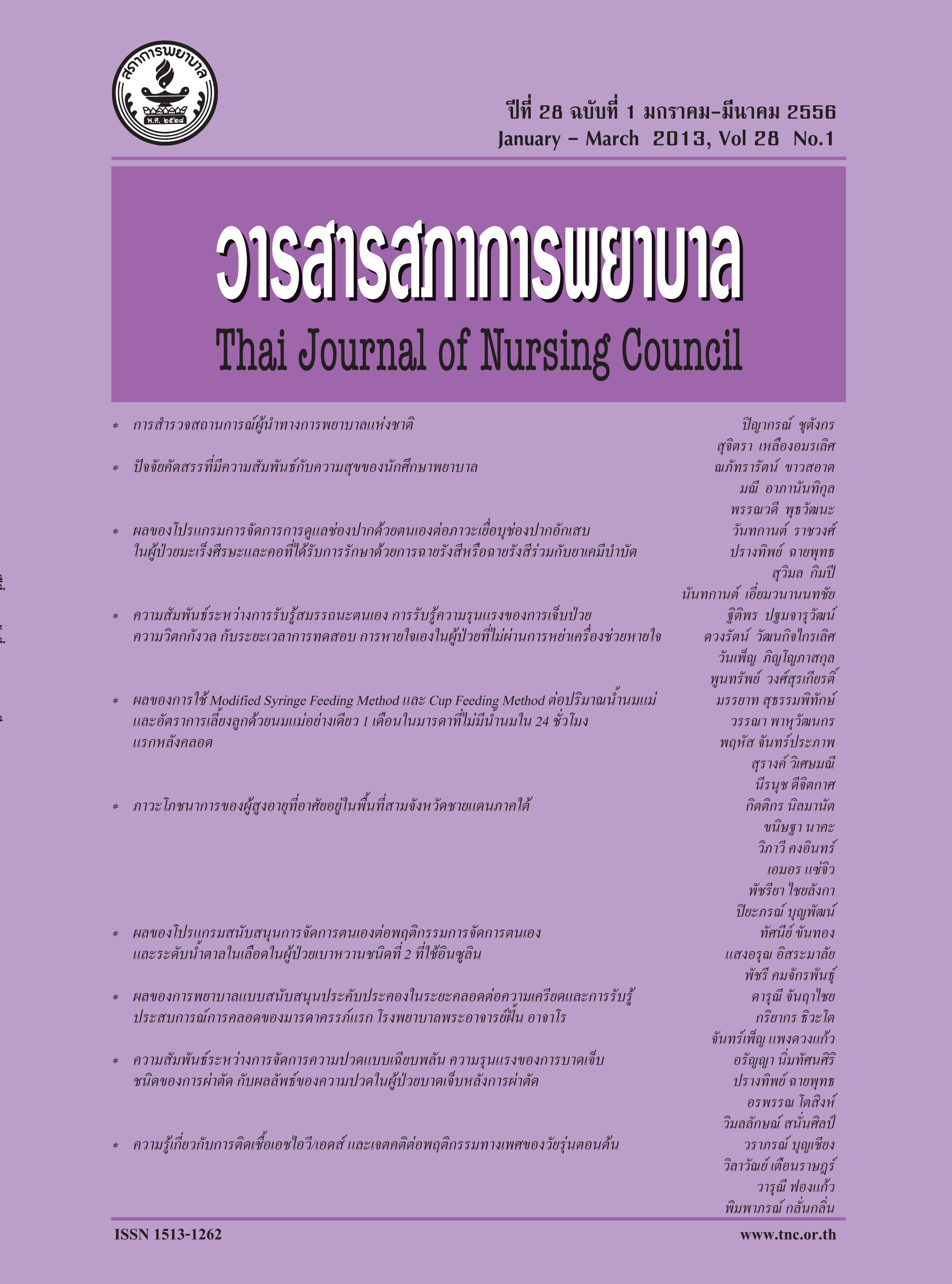ความสัมพันธ์ระหว่างการจัดการความปวดแบบเฉียบพลัน ความรุนแรง
Keywords:
ความปวดเฉียบพลัน, การจัดการความปวด, ผลลัพธ์ของความปวด, ความรุนแรง, acute pain, management of pain, pain outcome, severity of injuryAbstract
บทคัดย่อ:
วัตถุประสงค์ของการวิจัย: เพื่อศึกษาความสัมพันธ์ระหว่างการจัดการความปวดแบบเฉียบพลัน ความรุนแรงของการบาดเจ็บ ชนิดของการผ่าตัด กับผลลัพธ์ของความปวด ในผู้ป่วยบาดเจ็บหลังผ่าตัด การออกแบบวิจัย: การวิจัยเชิงบรรยายโดยวิเคราะห์หาความสัมพันธ์ (Descriptive correlational design)
การดำเนินการวิจัย: กลุ่มตัวอย่างเป็นผู้ป่วยบาดเจ็บหลังผ่าตัด 72 ชั่วโมงแรกจำนวน 88 รายที่เข้ารับการรักษาในโรงพยาบาลตติยภูมิ 1 แห่งและทุติยภูมิ 3 แห่ง เครื่องมือที่ใช้เก็บรวบรวม ข้อมูลได้แก่ แบบบันทึกการจัดการความปวด แบบประเมินความรุนแรง การบาดเจ็บ แบบสังเกต ความปวดระยะวิกฤต วิเคราะห์ข้อมูลโดยใช้สถิติหาความสัมพันธ์แบบไค-สแควร์ และค่าสัมประสิทธิ์ สหสัมพันธ์สเปียร์แมน
ผลการวิจัย: กลุ่มตัวอย่างเป็นเพศชายร้อยละ 87.5 อายุเฉลี่ย 36.51 ปี (S.D. = 14.96)มีการจัดการความปวดแบบเฉียบพลันร้อยละ 30.7 ความรุนแรงของการบาดเจ็บเฉลี่ย 21.93 คะแนน (S.D. = 9.10) เป็นการผ่าตัดเปิดช่องท้องเพื่อตรวจหาพยาธิสภาพร้อยละ 63.6 และมีผลลัพธ์ของความปวดเป็นอาการปวดร้อยละ 59.1 การจัดการความปวดแบบเฉียบพลันมีความสัมพันธ์เชิงลบกับผลลัพธ์ของความปวดอย่างมีนัยสำคัญทางสถิติที่ p <.05 [ (1, N = 88) = 5.43, p = .02] แต่ความรุนแรงของการบาดเจ็บและชนิดของการผ่าตัดไม่มีความสัมพันธ์กับผลลัพธ์ของความปวด
ข้อเสนอแนะ: การศึกษานี้ชี้ให้เห็นว่า การจัดการความปวดแบบเฉียบพลันมีความสัมพันธ์กับผลลัพธ์ของความปวด ดังนั้นพยาบาลที่ดูแลผู้ป่วยหลังผ่าตัดในระยะวิกฤต ควรคำนึงถึงการจัดการ ความปวดที่ประกอบด้วย การประเมินความปวดจากการสังเกตพฤติกรรมของผู้ป่วย การบำบัดความปวดทั้งใช้ยาและไม่ใช้ยาแก้ปวด และการบันทึกทางการพยาบาลเพื่อช่วยให้ผู้ป่วยฟื้นตัวได้เร็วขึ้น
วารสารสภาการพยาบาล 2556; 28(1) 111-123
คำสำคัญ: ความปวดเฉียบพลัน การจัดการความปวด ผลลัพธ์ของความปวด ความรุนแรงของการบาดเจ็บ
Correlation between Management of Acute Pain, Severity of Injury, Type of Surgery and Post-Operative Pain Outcome in Injured Patients
Arunya Nimthasanasiri M.N.S. (Adult Nursing)
Prangtip Chayaput Ph.D. (Nursing)
Orapan Thosingha D.N.S
Vimolluck Sanansilp M.D., Higher Grad. Dip. Clin. Sci. (Anesthesiology)
Abstract: Objective: To study correlation between management of acute pain, severity of injury, type of surgery and post-operative pain outcome in injured patients.
Research Type: Descriptive correlational design.
Research Procedure: The sample consisted of 88 injured patients in one tertiary hospital and three secondary hospitals, during the 72-hour post-operative monitored care.Data were collected using a pain management record form, an injury severity assessment form and a Critical Care Pain Observation Tool (CPOT). The data were analyzed using Chi-square and Spearman’s rank correlation coefficients.
Research Findings: The majority of the patients (87.5%) were male and averagely aged 36.51 years (S.D. = 14.96), and 30.7% had been introduced to management of acute pain. The average degree of their injury severity translated to 21.93 points (S.D. = 9.10).Sixty-three point six percent had undergone exploratory laparotomy and 59.1% identified pain score as a pain outcome. Management of acute pain showed a negative correlation with pain outcome, at a statistically significant level of p < .05 [ (1, N = 88) = 5.43, p = .02]; however, severity of injury and type of surgery displayed no correlation with pain outcome.
Recommendations: This study shows that management of acute pain closely correlates with pain outcome. For this reason, nurses caring for critical-stage post-operative patients are encouraged to apply an acute pain management method that involves pain assessment through patient observation, pharmacologic and non-pharmacologic approaches and nursingcare records, for the purpose of accelerated recovery.
Thai Journal of Nursing Council 2013; 28(1) 111-123
Keywords: acute pain; management of pain; pain outcome; severity of injury







